
The UCLA Herb Alpert School of Music presents
Anne LeBaron, a Portrait Concert
featuring heroines from around the globe
Wednesday, February 7, 2024
Lani Hall
445 Charles E Young Drive
Los Angeles, CA 90095
7:00 PM
Performers
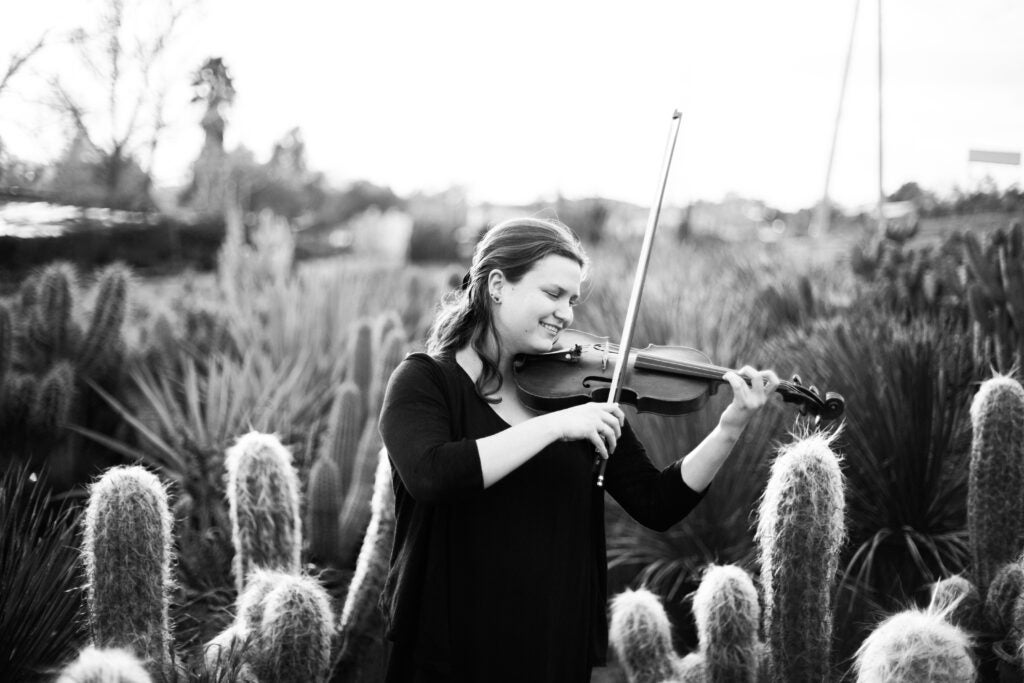
Adrianne Pope
See Bio
Adrianne Pope is a violinist and artist based in Los Angeles. As a chamber musician and promoter of new music, she is a member of the Grammy-nominated new music collective Wild Up and a founding member of Aperture Duo with Linnea Powell. Adrianne is a member of the Hollywood Bowl Orchestra and is an active freelance musician and soloist in the Los Angeles area. She has recorded and performed with legendary artists including The Beatles, Diana Ross, Violent Femmes, Earth, Wind & Fire, Randy Newman, Kool & The Gang and Cyndi Lauper, and can be found on soundtracks such as Indiana Jones and the Dial of Destiny, Avatar: The Way of Water, and Encanto. Besides performing, Adrianne enjoys repairing and rehairing bows, tap dancing, ocean swimming, and gardening.
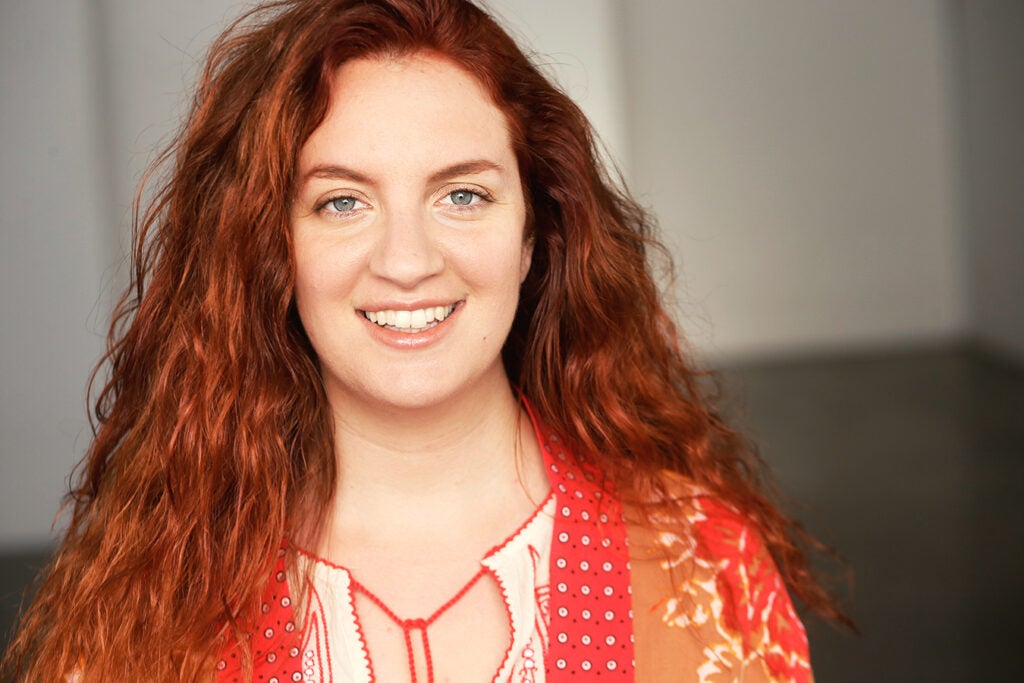
Elizabeth Setzer
See Bio
I’m Elizabeth (she/her/hers). I make music. I also enjoy acting, dancing, writing, teaching, and making art. I think and read a lot about feminism and collective liberation. I organize with folks in the West San Fernando Valley. I’m a survivor, and I live with complex PTSD. I’m queer, and vegan. I love a good piano bar. I hope you enjoy the videos, recordings, and words I’ve assembled here.
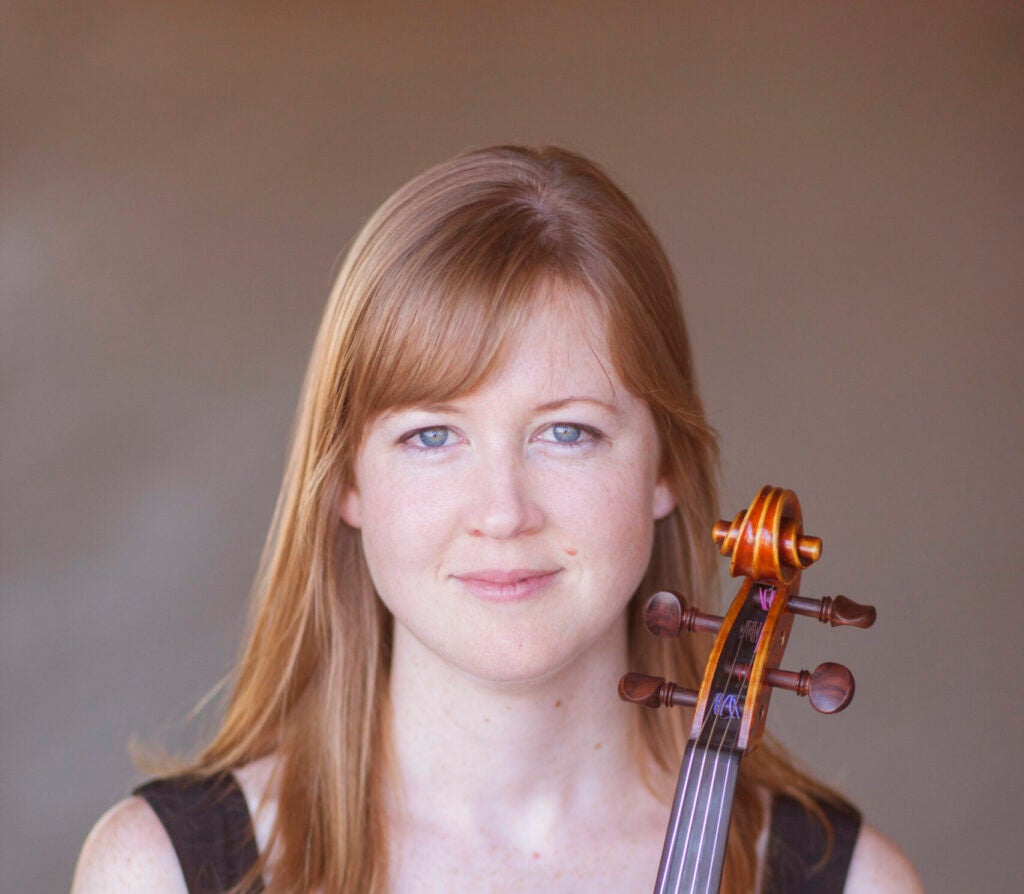
Linnea Powell
See Bio
Linnea Powell enjoys a multifaceted career as a freelance violist in the Los Angeles area, performing regularly as an orchestral, chamber, pit, and studio musician. An avid interpreter of new music, Linnea is a member of the Grammy nominated ensemble Wild Up and has performed and recorded with WasteLAnd, Jacaranda, and the Salastina Music Society. As a cofounder of LA-based Aperture Duo, Linnea regularly commissions and records new works for the violin/viola duo and has been featured repeatedly on the LA Phil’s Noon to Midnight Festival. Passionate about music education and the inner-workings of the arts, Linnea has served as Managing Director for Wild Up, Director of the Conejo Valley branch of Junior Chamber Music, and Director of ViolaFest Los Angeles.

Maria Elena Altany
See Bio
Maria Elena Altany is a third generation Xicana soprano from San Francisco, currently based in Los Angeles. She is known for her acrobatic high notes and daring performances on the cutting edge of opera and classical music. Her roles with LA Opera include Susanna in ¡Figaro!(90210) and Sacrifice in the premiere of Las Tres Mujeres de Jerusalén conducted by James Conlon. She recently starred in Mark Grey’s Birds in The Moon, in which Mark Swed of the Los Angeles Times declared that she “soars in song.” She premiered the role at the New York Philharmonic’s Bandwagon 2 Festival, and then at The Broad Stage in Santa Monica.
She is a Company Member of the groundbreaking opera company The Industry, led by MacArthur Fellow Yuval Sharon. With The Industry, she has performed featured roles in Anne LeBaron’s Crescent City, Chris Cerrone’s Invisible Cities, an adaptation of Brecht’s Galileo, and Hopscotch: An Opera for 24 Cars,for which she was featured in The New Yorker. Recent appearances include Al Sur de la Frontera at The Ford Amphitheatre with BossWitch and The LA Phil, John Cage’s Europeras 1 & 2 with the LA Phil and The Industry, the workshop of Esperanza Spalding and Wayne Shorter’s opera …(Iphigenia), and Susanna in Ragnar Kjartansson’s BLISS with wild Up!, as part of the LA Philharmonic’s Fluxus festival. Maria Elena appears in The Industry’s Sweet Land, which is available for streaming purchase, and in LA Opera’s video production of Mozart’s Opera Tales. She maintains a private voice studio in Long Beach.
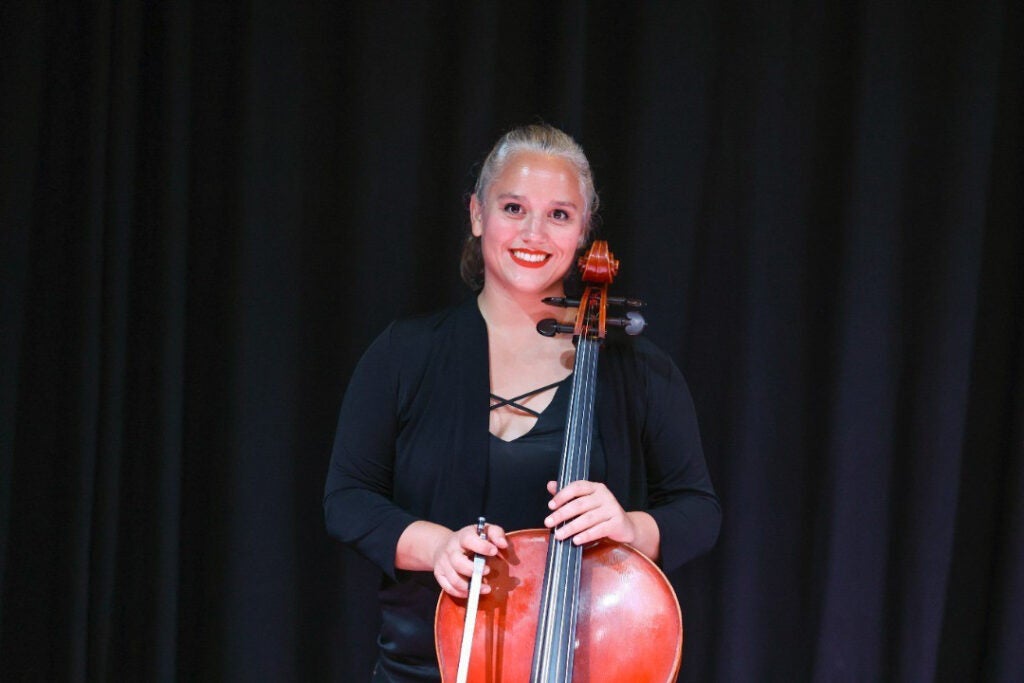
Mia Barcia-Colombo
See Bio
Born and raised in Los Angeles, California, Mia Barcia-Colombo began her musical studies on piano at the age of four, switching to cello at age eight. Mia spent her formative years studying at the Colburn School as well as USC Thornton School of Music with Eleonore Schoenfeld, where she sat principal cello of both the Colburn Chamber Orchestra and American Youth Symphony. She completed her Bachelor’s Degree at the Peabody Institute in Baltimore, Maryland, under the instruction of Amit Peled. Mia is currently a Los Angeles based cellist whose eclectic and diverse performance career spans multiple musical industries. She spends extensive time performing newly written and commissioned works with acclaimed contemporary ensembles Wild Up and Brightwork New Music, and can be found on Wild Up’s latest Grammy Nominated album in their Julius Eastman Anthology. Mia is also starting her eighth season performing as a principal cellist of genre-bending group Nu Deco Ensemble in Miami, Florida. She also serves as a regular substitute cellist with the Los Angeles Philharmonic, where she has performed extensively under the batons of renowned conductors such as Gustavo Dudamel, Esa-Pekka Salonen, John Williams, Thomas Adès, Itzhak Pearlman, Stéphane Denève, John Adams, and Zubin Mehta.
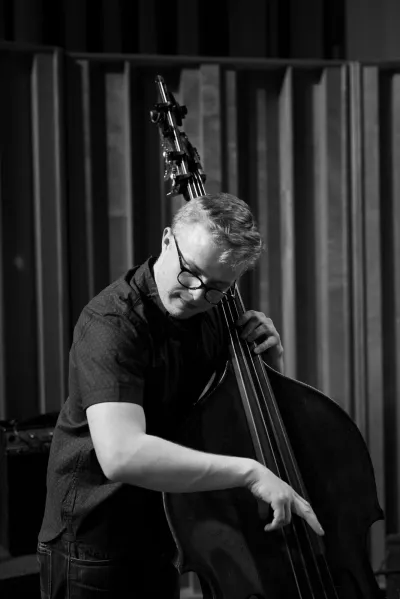
Miller Wrenn
See Bio
“One of Los Angeles’ most fearless improvisers,” Miller Wrenn is a Los Angeles-based bassist and composer-improviser. He works primarily in the fields of new, creative, and improvised music. He performs and records frequently in a wide variety of contexts and has been fortunate to do so with artists such as Vinny Golia, Eyvind Kang, Hildur Guðnadóttir, Stephanie Richards, Dan Rosenboom, Alex Cline, Vicki Ray, GE Stinson, Mark Menzies, Larry Koonse, Joe LaBarbera, Tony Malaby, and many others.
Repertoire
All music composed by Anne LeBaron (b. 1953)
Noh Reflections
Movement II
Adrianne Pope, violin
Linnea Powell, viola
Mia Barcia-Colombo, cello
*The Heroine with a Thousand Faces
Memphis Minnie
Marilyn Monroe
Abby Wambach
Elizabeth Setzer, piano
“Homesick Woman”
from Crescent City
libretto: Douglas Kearney
Maria Elena Altany, soprano
Elizabeth Setzer, piano
*The Heroine with a Thousand Faces
Leymah Gbowee
Julieta Dobles
Ruth Bader Ginsberg
Mary Helen MacKillop
Susan B. Anthony
Jan Berry Baker, soprano and alto saxophone
*Two Kazakh Songs
Black of My Eye
poem: Abai Kunanbaev
I am a Kazakh
poem: Zhyban Moldagaliev
Timur Bekbosunov, tenor
Elizabeth Setzer, piano
“Elegy”
from Pope Joan
libretto: Enid Shomer
Maria Elena Altany, soprano
Adrianne Pope, violin
Linnea Powell, viola
Mia Barcia-Colombo, cello
Infrathin IV
Timur Bekbosunov, tenor
Jan Berry Baker, soprano saxophone
Anne LeBaron, harp
Elizabeth Setzer, piano
Miller Wrenn, contrabass
Inner Voice
Miller Wrenn, contrabass
“Green Card”
from Croak (The Last Frog)
lyrics: Anne LeBaron
book: Leslie Jacobson
Timur Bekbosunov, tenor
Elizabeth Setzer, piano
Miller Wrenn, contrabass
*world premiere
Program Notes
All program notes written by composer Anne LeBaron.
NOH REFLECTIONS
William P. Malm, in Japanese Music and Musical Instruments, describes Noh theater as a balance between “highly refined abstraction and the dramatic necessity of human emotions.” This idea of contrast and balance was a motivating force behind Noh Reflections, scored for string trio: violin, viola, and cello. I was also attracted to the mosaic-like structure of a Noh play, with its juxtapositions and overlapping of rigidly defined units. Furthermore, the tension between order and plasticity in the music gives an impression of tightly controlled spontaneity.
My first exposure to this unparalleled art form occurred in 1983 in Tokyo. A year later, a Noh performance in New York revitalized my interest, and I began composing the string trio, impelled to capture the sound-sense of Noh. My intention was to create a framework for the trio by exploring the ways that Western string instruments might simulate the sustaining tones and blurring glissandi of the Noh flute, the crisp percussive attacks of the drums, and the variations in vibrato, portamento, and tone projected by the voices.
Noh Reflections most clearly distills the sounds and music of Noh at the beginning of the first movement. Contrasting material later overpowers these initial impressions until the very end of the composition, when the Noh-inspired material resurfaces. Noh Reflections was awarded the McCollin Prize by the Musical Fund Society of Philadelphia in 1986.
THE HEROINE WITH A THOUSAND FACES (piano)
Memphis Minnie; Marilyn Monroe; Abby Wambach
The Heroine with a Thousand Faces is a multi-year project for which I will compose one thousand short works. These works will serve as a collection of musical portraits of women who have made visionary, courageous, and often unheralded contributions to our world. Each piece will be composed for a solo instrument, primarily piano, although some will be written for chamber ensembles. The composition must be initiated, and ideally completed, on the birthday of the subject.
Born in Algiers, Louisiana (1887-1973), Lizzie Douglas was the birth name of Memphis Minnie, known as the “Queen of the Blues.” A singer, guitarist, and songwriter, her performances and innovations spanned decades. With a style rooted in country blues, she contributed to the blues’ urban transformation in the 1950s when she relocated to Chicago.
Originally named Norma Jeane Mortenson when she was born in Los Angeles, Marilyn Monroe (1926-1962), the iconic world-renowned actress, was an avid reader. Her library of hundreds of books and her diary entries revealed her passion for writers such as James Joyce, Samuel Beckett, and Walt Whitman.
Abby Wambach (1980 - ), a two-time Olympic gold medalist and six-time winner of the U.S. Soccer Athlete of the Year Award, set many records as a champion soccer player prior to her retirement. She remains active as an author, speaker, and proponent of equity and inclusion.
HOMESICK WOMAN from Crescent City
After escaping the rising floodwaters, the Homesick Woman returns on a bus to her home in the Ninth Ward of Crescent City and to her husband, the Good Man. She grieves for her two children who drowned.
My opera Crescent City tells a kaleidoscopic tale of a fictional city barely functioning after one hurricane and now threatened by another. The supernatural figure of legendary voodoo queen Marie Laveau emerges from her tomb to try and save the city from annihilation while marauding revelers celebrate an apocalyptic final party as the world comes to an end. The hallucinatory musical colors extend beyond conventional opera with electronica, non-traditional vocal techniques, and experimental jazz. Crescent City was produced by The Industry, with a run of twelve performances in Los Angeles in 2012 and directed by Yuval Sharon. The libretto is by Douglas Kearney.
Lyrics:
“Please hold me, don’t let me go.”
I left him.
The water rose, pulled me to its arms.
It took my babies, I looked for them,
searched the lakes and rivers.
I found nothing but water,
oh, nothing in this world but empty water.
How I wanted to drown;
Love me o water.
I left my man,
just left him there.
I left him.
Please hold me.
Don’t let me go.
It took my babies,
the water rose.
Oh how I wanted to drown!
“Please hold me.
Don’t let me go.”
I left him.
I searched the lakes and rivers,
Nothing in this world but empty water.
How I wanted to drown.
Love me o water,
o love me.
THE HEROINE WITH A THOUSAND FACES (soprano and alto saxophone)
Leymah Gbowee; Julieta Dobles; Ruth Bader Ginsberg; Mary Helen MacKillop; Susan B. Anthony
This set of five musical portraits, commissioned by the Davise Fund and composed for soprano and alto saxophone, is written for and dedicated to Jan Berry Baker.
Leymah Gbowee (b. 1972), a Liberian Nobel Prize winner and peace activist, is best known for leading a nonviolent movement that helped to unite Christian and Muslim women. Bringing these women together in the name of stopping the war played a significant role in ending the 14-year Liberian civil war in 2003. The subsequent election of Africa’s first female head of state, Liberian President Ellen Johnson Sirleaf, owed much to Gbowee’s efforts.
Julieta Dobles (b. 1943) is a Costa Rican poet, writer and educator, and winner of the 2013 Magnon National Cultural Award. As one of the founders of the Transcendentalist Movement in Costa Rica, she signed the Manifiesto transcendentalista in 1977. Her provocative poetry imbues the erotic with a liberating and empowering energy.
Ruth Bader Ginsberg (1933-2020) was the first Jewish woman to serve on the Supreme Court, and the second woman after Sandra Day O’Connor. She advocated for gender equality and women’s rights. My musical portrait of Ginsberg reflects her devotion to and enthusiasm for opera.
Mary Helen MacKillop (1842-1909), also known as Mary of the Cross, is the first Australian to be recognized as a saint. Her extraordinary career of dedication to education for the poor, support for orphans, and care for women prisoners, was also marked by clashes with Catholic priests and bishops. Due to her actions that exposed a pedophile priest, she is informally considered to be a patron saint of sexual abuse victims.
Susan B. Anthony (1820-1906) was one of the most visible leaders of the women’s suffrage movement, along with Elizabeth Cady Stanton. They formed the National Woman Suffrage Association in 1890 as part of a crusade for a constitutional amendment giving women the right to vote. In 1872, two decades earlier, Anthony was arrested for voting, and fined $100. She refused to pay. In her speech given to legislators the following year, “Is it a Crime for a U.S. Citizen to Vote?” she argues that she committed no crime. This excerpt from her speech is central to my musical portrait of her:
It is urged that the use of the masculine pronouns he, his, and him in all the constitutions and laws, is proof that only men were meant to be included in their provisions. If you insist on this version of the letter of the law, we shall insist that you be consistent and accept the other horn of the dilemma, which would compel you to exempt women from taxation for the support of the government and from penalties for the violation of laws. There is no she or her or hers in the tax laws, and this is equally true of all the criminal laws.
TWO KAZAKH SONGS:
Black of My Eye; I am a Kazakh
Both songs are adapted from Silent Steppe Cantata, commissioned by the JSC Sovereign Joint Stock Wealth Fund “Samruk-Kazyna,” with premieres in Almaty and Astana in 2011. Composed for the Sary-Arka Folk Instrument Orchestra and the Chamber Choir of the Astana Philharmonic Society, the performances featured the brilliant tenor Timur Bekbosunov, set to poems moving among three languages—Russian, Kazakh, and English. The Kazakh press praised the cantata as one of the most important classical contemporary musical events of the past forty years in Central Asia.
A revered Kazakh poet, composer, theologian, and philosopher, Abai, credited with “Black of My Eye,” was also a cultural reformer (European and Russian) on the basis of enlightened Islam. The lyrics to "I am a Kazakh" were penned by Kazakh poet, translator, and journalist Moldagaliev Zhuban.
BLACK OF MY EYE
Black of my eye
Frame of my mind.
Drink never dry
Love of my life.
Parting is winter,
your absence is sorrow.
I wish to stay
until the morrow,
Between your fair arms
when the nightingale sings “terrow.”
The corners of your eyes
sparkle and they glisten.
When you speak your solid words
everyone will listen.
Black of my eye
Frame of my mind.
Drink never dry
Love of my life.
I AM A KAZAKH
I am a Kazakh.
I died and rose from the dead
thousands of times.
I laughed and light
appeared from the darkness.
I cried and I saw
tears in the sun’s eyes.
I am a Kazakh,
and once I heard
the steppe began to tremble.
What was it…
what?
It was thunder,
thunder and roar
of the twentieth century.
Its echo was heard
in all corners of the steppe
as a long-wished song
for the wishful soul.
I am a Kazakh.
I cry to the setting sun.
I am a Kazakh.
I whisper to the rising sun.
When I cried
the sun got dark in the sky.
When I laughed
the darkness turned into light.
ELEGY from Pope Joan
Pope Joan, a dance opera, was co-commissioned in 2000 by Dance Alloy and the Pittsburgh New Music Ensemble. Enid Shomer’s poems are imagined as documents found on the body of Pope John VIII at his/her death.
According to many documented sources, the future Papessa began her calling in the ninth century as an ecclesiastic scribe. She joined a Benedictine monastery at the insistence of her first lover and later moved to Athens and Rome, where, still disguised as a man, she became cardinal and then, in 856, Pope John VIII. She was stoned to death after giving birth to a child during a papal procession in 858.
“Elegy,” sung to her unborn child, is accompanied by a string trio drawn from the larger chamber music ensemble active in the other movements.
Lyrics
O lift the tiny feet and hands, lift the head carefully as a jug of wine, as blown glass. Rinse the eyes clear. Part and comb the fine hair, and in the desk drawer sift among the clutter for the small gold crucifix to be worn around his neck---a rose of Sharon, its blossoms raging against the base of the cross. Be wary of drafts and cold linens. Remember when you walk, he’s not safely tucked inside like a foot curled away from a fire, but rides noisily upon your arm, precariously upon your arm. Glide like a blade of light! The air, the sunny air which polishes his cheeks and fills his eyes with sky cannot catch him if he falls.
INFRATHIN IV
Marcel Duchamp’s description of infrathin: “The difference (dimensional) between 2 mass-produced objects [from the same mold] is an infra thin when the maximum precision is obtained.” Duchamp hoped to heighten the observer’s sensitivity to difference, the smallest possible, indeed imperceptible, difference between two seemingly identical phenomena or moments. With this text and graphic score I’ve drawn upon the poetic sensibility of the Duchampian infrathin, translated into sound and music.
INNER VOICE
Four primary sources form the sound environment, enveloping the performer at times, and providing a contrasting backdrop at other times. From the bowels of the earth, the endless lashings of water against lava and sandstone in a blowhole on the island of Maui alternately merge with fragmented and filtered phrases from the old gospel tune, “I’ll Fly Away,” and with a trio of actors intoning “Why This.” The sonorous clappings of wood against an ancient temple bell residing at the Jodo Mission in Lahaina, Maui, provide resonant punctuation as well as evaporative elements that conjoin with the voices. (Sadly, the temple was destroyed in the 2023 fire that struck Lahaina, but the temple bell survived, along with the copper Great Buddha statue and the wooden Amida Buddha statue.)
The music for contrabass, with a vocal part to expand its range, becomes wed via harmonics and other coloristic techniques to the spectra of the water/earth and metal/wood elements, as well as the wind in the breath of the intoning voices. These diverse sources reflect, individually and collectively, the inner voice of the earth, of a wooden stringed instrument, of a forged hunk of metal refined to call forth spirits, and of humanity as expressed by the voice.
GREEN CARD from Croak (The Last Frog)
Croak (The Last Frog) depicts the journey of Cassandra (aka Cassie), the last frog on earth. After traveling the globe singing of the plight of vanishing amphibians and outliving them all, she arrives at her final resting place in the Cloud Forest of Monteverde, Costa Rica. Before departing from this world, memories of creatures from her youth come flooding back. With the song “Green Card,” she reflects on her stint as a showgirl at the Herp Haven Hotel in Las Vegas. The non-documented waiter Goliath, a jumping frog who dreams of a green card, fantasizes about a relationship with Cassie. (Fun fact: the actor Kerry Washington, up-and-coming at the time, performed the part of Cassie at the Washington D.C. premiere.) Book by Leslie Jacobson and lyrics by Anne LeBaron.
Lyrics
I spend every spare minute of time on preparation.
I have every ambition to eat the competition.
I’m not in this country legally, that’s why I work out.
Surreptitiously I spend every spare minute I have.
Day and night I dream
of a card that’s green.
When I win the Calaveras County Frog Jump Jubilee,
I’ll make my country proud, I’ll be allowed to stay here without fear.
I wish you would come with me and witness my transformation
from a lowly alien.
This could be my chance
at a new romance.
Day and night I dream
of a card that’s green.
If they say I can’t hop because of my weight,
we can appeal to the Kazakh Consulate.
If that doesn’t work another tactic is in order,
voracious, rapacious, that’s just for starters.
My exotic physique will create a stir.
My soaring leaps at the competition will impress her.
I am lean and mean,
number one jumping machine.
My status as a guest
will soon be put to rest.
Day and night I dream
of a card that’s green.
This concert marks my retirement from CalArts, where I’ve taught for twenty-two years, and celebrates a significant birthday milestone. Special thanks to Nina Eidsheim, faculty sponsor; Jan Berry Baker, for whom five of the Heroines were composed; Matthew Vest, administrator of the Davise Funds from the School of Music Library; Madeline Falcone and Mason Moy, producer and associate producer; and all of the marvelous musicians performing my music.
-Anne LeBaron